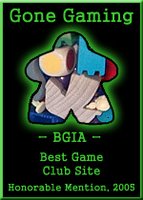Luch strained his back. Ouch. He didn't make it.
San Juan
Bharmer, Kozure and myself played two games of San Juan over the course of the evening ("because it was on the table" Bharmer said). My appreciation for this game is growing every time I play it with three players... creating synergies between the roles and the cards takes some skill yet there is enough luck to keep things interesting. I loved that Kozure decided to play a card we had all decided wasn't worth using (the black market), only to find that it was indeed quite good. I somehow doubt that all the cards are perfectly balanced according to cost vs. benefit but it's nice to know that even the ones that look like dogs just need the right strategy to become useful (although the player with the palace often seems to win...). Bharmer won the first game and Kozure won the second.
Terakh
Kozure finally got Terakh to the table, a game I'd seen brought to several games nights but never played.
Terakh is a combat game that looks (and somewhat behaves) like an abstract. The board consists of a number of triangular sections put together in various ways according to the number of players. The pieces are also all geometric shapes: Pyramid "Elders", cylindrical "Incas", circular "Orbs" and eight sided "Dice". Despite the abstract nature of the components (and peculiar nomenclature), the actual game is pretty down to earth: To use Chess analogies, each player has several pawns, one queen and one king. Pieces are moved, pawns, queens and kings are captured. The last player with a King on the board wins.
Obviously, in practice there is a lot more than that going on. On a turn, players use 5 action points to determine who does what (and how much). The pawns must assume an offensive or defensive stance and then use die rolls to determine the winner of a combat. The queen is actually a pawn imbued with special powers (each player has a unique set of powers according to the colour they are playing). There are teleportation spots and the boards can be rotated during play. In addition, spell cards are distributed at the beginning of each round and can be used to affect the gameplay in various ways. As I said, it really feels more like a mini-wargame when you are playing than some sort of GIPF game... but you'd never know it from the components.
It's a fun game. The individual powers seem to do a good job of differentiating the experiences for the players. The spells inject an unpredictability to the events which unfold. The types of pieces, the manipulation of the board, etc feel well thought out and integrated. Although I didn't care for the illustrations on the pieces (or of the presentation of the game or gamebox in general), I did find the illustrations on the cards humourous.
I started out quite strong, and actually felt pretty much in control for the first little while. My die was hot, rolling far more 8s than I deserved. I played the Hydra clan and my ability to attack up to three opponents at once was forcing Kozure to retreat and spread out early on. At some point, I started making stupid moves (like forgetting my teleport ability, and like counting on low odds attacks to prevent my elder from getting destroyed). My idol was destroyed by Kozure before I could finish him and my elder was beaten down by Bharmer (who was playing a rather conservative game until that point). He eventually took out Kozure for the win.
For Sale!
We finished up with For Sale! Not much to say, except that I quite enjoy this game for what it is. I won over Kozure by 1 dollar!
Subscribe to:
Post Comments (Atom)


No comments:
Post a Comment